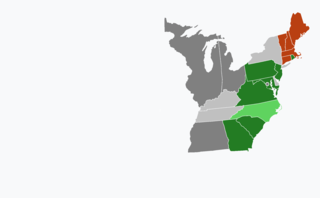
The 1808–09 United States Senate elections were held on various dates in various states, coinciding with the 1808 presidential election. As these U.S. Senate elections were prior to the ratification of the Seventeenth Amendment in 1913, senators were chosen by state legislatures. Senators were elected over a wide range of time throughout 1808 and 1809, and a seat may have been filled months late or remained vacant due to legislative deadlock. In these elections, terms were up for the senators in Class 1.

The 1814–15 United States Senate elections were held on various dates in various states. As these U.S. Senate elections were prior to the ratification of the Seventeenth Amendment in 1913, senators were chosen by state legislatures. Senators were elected over a wide range of time throughout 1814 and 1815, and a seat may have been filled months late or remained vacant due to legislative deadlock. In these elections, terms were up for the senators in Class 1.

The 1802–03 United States Senate elections were held on various dates in various states. As these U.S. Senate elections were prior to the ratification of the Seventeenth Amendment in 1913, senators were chosen by state legislatures. Senators were elected over a wide range of time throughout 1802 and 1803, and a seat may have been filled months late or remained vacant due to legislative deadlock. In these elections, terms were up for the senators in Class 1.

The 1801 Rhode Island gubernatorial election was an uncontested election held on April 1, 1801 to elect the Governor of Rhode Island. Arthur Fenner, the incumbent Governor, was the sole candidate and so won with 100% of the vote.

United States gubernatorial elections were held in 1800, in 11 states, concurrent with the House, Senate elections and presidential election.

United States gubernatorial elections were held in 1801, in 13 states.

United States gubernatorial elections were held in 1802, in 12 states, concurrent with the House and Senate elections.

United States gubernatorial elections were held in 1804, in 13 states, concurrent with the House, Senate elections and presidential election.

United States gubernatorial elections were held in 1810, in 13 states, concurrent with the House and Senate elections.

United States gubernatorial elections were held in 1806, in 10 states, concurrent with the House and Senate elections.

United States gubernatorial elections were held in 1805, in 13 states.

The 1798 New Hampshire gubernatorial election took place on March 13, 1798. Incumbent Federalist Governor John Taylor Gilman won re-election to a fifth term, easily defeating various minor candidates.

The 1803 New Hampshire gubernatorial election took place on March 8, 1803. Incumbent Federalist Governor John Taylor Gilman won re-election to a tenth term, defeating Democratic-Republican candidate, former Governor and United States Senator John Langdon in a re-match of the previous year's election.

The 1801 Connecticut gubernatorial election was held on April 9, for elected Governor of Connecticut, Incumbent Governor Jonathan Trumbull Jr, won re-election to a fourth full term, defeating Democratic-Republican candidate Richard Law

The 1802 Connecticut gubernatorial election took place on April 8, 1802. Incumbent Federalist Governor Jonathan Trumbull Jr. won re-election to a fifth full term, defeating Democratic-Republican candidate Ephraim Kirby.

The 1803 Connecticut gubernatorial election took place on April 14, 1803. Incumbent Federalist Governor Jonathan Trumbull Jr. won re-election to a sixth full term, defeating Democratic-Republican candidate Ephraim Kirby in a re-match of the previous year's election.

The 1804 Connecticut gubernatorial election took place on April 12, 1804. Incumbent Federalist Governor Jonathan Trumbull Jr. won re-election to a seventh full term, defeating Democratic-Republican candidate William Hart.

The 1807 Connecticut gubernatorial election took place on April 9, 1807. Incumbent Federalist Governor Jonathan Trumbull Jr. won re-election to a tenth full term, defeating Democratic-Republican candidate William Hart in a re-match of the previous year's election.
The 1807 Massachusetts gubernatorial election was held on April 6, 1807.

The 1814 Connecticut gubernatorial election took place on April 11, 1814.
















